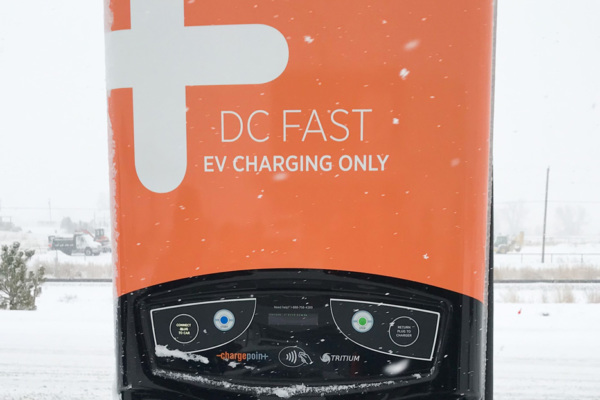Charging times for plug-in electric vehicles vary based on how depleted the battery is, how much energy it holds, the type of battery, and the type of charging equipment used. There are three types of chargers: Level 1, Level 2 and DC Fast Charging.
Level 1 Charging
Alternating Current (AC) Level 1 equipment provides charging through a 120 volt (V) AC plug. Vehicles use a Level 1 cordset. On one end of the cord is a standard NEMA connector and on the other end is an SAE J1772 standard connector. The J1772 connector plugs into the car's J1772 charge port, and the NEMA connector plugs into a standard NEMA wall outlet. All Tesla vehicles come with a J1772 adapter, which allows them to use non- Tesla charging equipment.
Level 1 charging is typically used when there is only a 120 V outlet available, such as while charging at home. Typically, eight hours of charging at 120 V can replenish about 40 miles of electric range for a mid-size PEV. As of 2020, less than 5 percent of public EVSE ports in the United States were Level 1.
Level 2 Charging
AC Level 2 equipment offers charging through 240 V, typical in residential applications, or 208 V, typical in commercial applications, electrical service. Most homes have 240 V service available, and because Level 2 equipment can charge a typical PEV battery overnight, PEV owners commonly install it for home charging. Level 2 equipment is also commonly used for public and workplace charging. This charging option can operate at up to 80 amperes (Amp) and 19.2 kW. As of 2020, over 80 percent of public EVSE ports in the United States were Level 2.
Level 2 charging equipment uses the same J1772 connector that Level 1 equipment uses. All commercially available PEVs have the ability to charge using Level 1 and Level 2 charging equipment.
DC Fast Charging
Direct-current (DC) fast-charging equipment, typically 208/480 VAC three-phase input, enables rapid charging along heavy traffic corridors at installed stations. As of 2020, over 15 percent of public EVSE ports in the United States were DC fast chargers. There are three types of DC fast-charging systems, depending on the type of charge port on the vehicle: SAE Combined Charging System (CCS), CHAdeMO and Tesla. The CHAdeMO connector is the most common of the three connector types.
The CCS connector (also known as J1772 combo) is unique because a driver can use the same charge port when charging with Level 1, Level 2 or DC fast-charging equipment. The only difference is that the DC fast-charging connector has two additional bottom pins.
Tesla vehicles have a unique connector that works for all their charging levels including their fast-charging option, called a Supercharger. Although Tesla vehicles do not have a CHAdeMO charge port and do not come with a CHAdeMO adapter, Tesla does sell an adapter.
// NATSO Launches EV Charging Funding Opportunities Online Resource
At NATSO, we want to ensure that NATSO members have all of the resources necessary to guide truckstops, travel plazas and off-highway fuel retailers as they invest in EV charging stations, whether you are planning investments for today or in the future. With that goal in mind, NATSO has created an online resource: “EV Charging Funding Opportunities.”
Subscribe to Updates
NATSO provides a breadth of information created to strengthen travel plazas’ ability to meet the needs of the travelling public in an age of disruption. This includes knowledge filled blog posts, articles and publications. If you would like to receive a digest of blog post and articles directly in your inbox, please provide your name, email and the frequency of the updates you want to receive the email digest.


